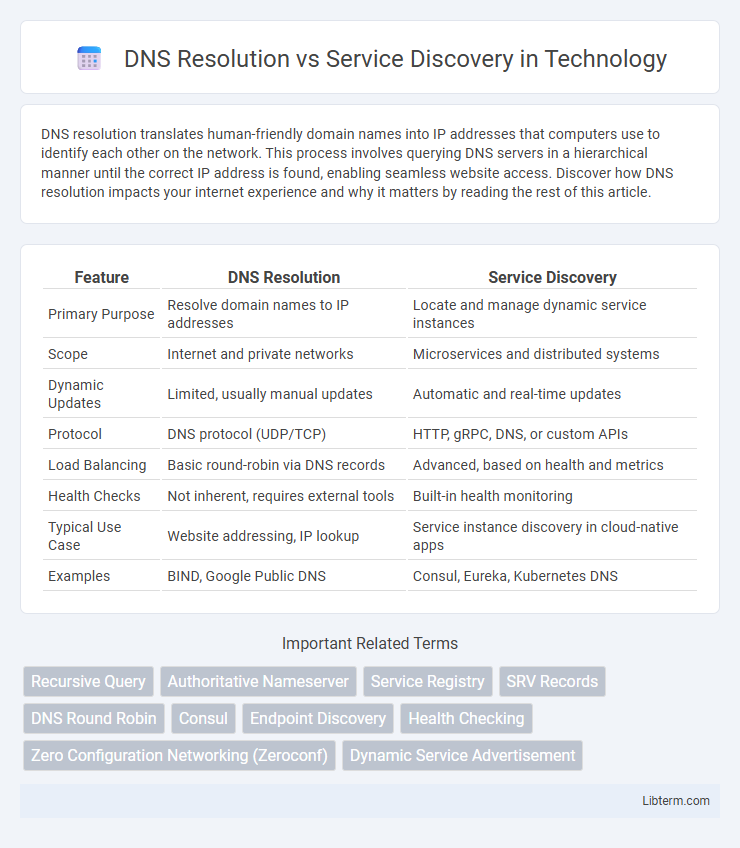DNS resolution translates human-friendly domain names into IP addresses that computers use to identify each other on the network. This process involves querying DNS servers in a hierarchical manner until the correct IP address is found, enabling seamless website access. Discover how DNS resolution impacts your internet experience and why it matters by reading the rest of this article.
Table of Comparison
| Feature | DNS Resolution | Service Discovery |
|---|---|---|
| Primary Purpose | Resolve domain names to IP addresses | Locate and manage dynamic service instances |
| Scope | Internet and private networks | Microservices and distributed systems |
| Dynamic Updates | Limited, usually manual updates | Automatic and real-time updates |
| Protocol | DNS protocol (UDP/TCP) | HTTP, gRPC, DNS, or custom APIs |
| Load Balancing | Basic round-robin via DNS records | Advanced, based on health and metrics |
| Health Checks | Not inherent, requires external tools | Built-in health monitoring |
| Typical Use Case | Website addressing, IP lookup | Service instance discovery in cloud-native apps |
| Examples | BIND, Google Public DNS | Consul, Eureka, Kubernetes DNS |
Introduction to DNS Resolution and Service Discovery
DNS resolution translates human-readable domain names into IP addresses, enabling devices to locate and connect over the internet efficiently. Service discovery automates the detection and management of network services within dynamic environments, often using protocols like mDNS, DNS-SD, or Consul. Both DNS resolution and service discovery enhance connectivity, but DNS primarily resolves static domain names, while service discovery adapts to changing network topologies and device availability.
Key Concepts: What is DNS Resolution?
DNS Resolution is the process of translating a human-readable domain name, such as www.example.com, into an IP address that computers use to identify each other on the network. This system relies on a distributed database of DNS servers that respond to queries and provide the corresponding IP addresses, enabling seamless internet navigation. Key components of DNS Resolution include recursive resolvers, authoritative name servers, and caching mechanisms that improve response times and reduce network traffic.
Understanding Service Discovery Mechanisms
Service discovery mechanisms enable dynamic identification and connection to services within distributed systems by maintaining updated registries of available service instances, unlike traditional DNS resolution which maps fixed domain names to IP addresses. Modern service discovery protocols, such as Consul, Eureka, and etcd, support health checking, load balancing, and automatic failover to enhance reliability and scalability. These mechanisms address the complexities of microservices architectures by providing real-time service location information, thereby optimizing network traffic and improving application resilience.
Differences Between DNS Resolution and Service Discovery
DNS resolution translates domain names into IP addresses to enable network communication, functioning primarily as a hierarchical naming system. Service discovery identifies available services, their locations, and metadata within dynamic environments, often supporting load balancing and health checks. Unlike DNS resolution's static mapping, service discovery emphasizes real-time service availability and instance information.
Use Cases for DNS Resolution
DNS resolution is crucial for mapping domain names to IP addresses, enabling web browsers to locate websites, emails to route correctly, and applications to communicate across networks. It is widely used for internet browsing, email delivery, and any service requiring hostname translation for connectivity. Businesses rely on DNS resolution to ensure seamless access to cloud services, online platforms, and distributed systems.
Use Cases for Service Discovery
Service discovery plays a crucial role in microservices architectures, enabling dynamic detection and communication between services without manual configuration. Unlike DNS resolution, which maps domain names to IP addresses for general internet navigation, service discovery handles ephemeral endpoints, load balancing, and real-time health checking across distributed systems. Use cases include container orchestration platforms like Kubernetes, where services need automatic registration and lookup for scaling, failover, and seamless integration within cloud-native environments.
Performance and Scalability Considerations
DNS resolution relies on caching and hierarchical queries to quickly translate domain names to IP addresses, offering robust performance for static environments but facing latency in dynamic service topologies. Service discovery systems optimize scalability by actively monitoring service health and availability, enabling efficient traffic routing in microservices architectures with frequent changes. While DNS is highly scalable due to decentralized servers, service discovery provides better performance in rapidly evolving infrastructure by reducing stale information and supporting real-time updates.
Security Implications in DNS and Service Discovery
DNS resolution relies on hierarchical queries that are susceptible to attacks such as DNS spoofing and cache poisoning, potentially redirecting users to malicious sites and compromising data integrity. Service discovery mechanisms, often used in microservices architectures, require secure authentication and encryption protocols to prevent unauthorized access and man-in-the-middle attacks within dynamic environments. Implementing DNSSEC for DNS and mutual TLS for service discovery enhances the security posture by ensuring data authenticity and confidentiality throughout network communications.
Integrating DNS Resolution with Service Discovery
Integrating DNS Resolution with Service Discovery enhances dynamic application environments by enabling automatic identification of services through DNS queries. This approach leverages DNS protocols to resolve service instances, reducing the need for hardcoded IP addresses and facilitating load balancing and failover. By combining DNS Resolution with real-time service registries, systems achieve efficient scalability and resiliency in microservices architectures.
Choosing the Right Solution for Modern Architectures
DNS resolution efficiently translates domain names to IP addresses, making it ideal for static or less dynamic environments. Service discovery excels in modern microservices architectures by providing real-time updates on service availability, health, and location. Selecting the right solution depends on architectural complexity, scalability requirements, and whether dynamic service management is critical for system performance.
DNS Resolution Infographic

 libterm.com
libterm.com